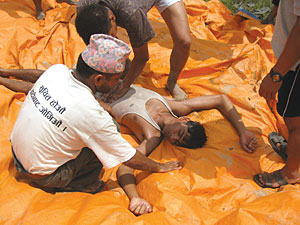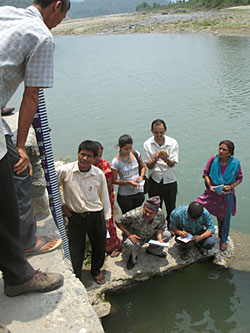 |
"At 3am I heard my neighbour scream. I ran to his house and saw his whole family standing in a foot of water. We realised we were being flooded. The water level rose quickly. We didn't have time to collect anything, we just ran for our lives," recalls Shakil Ahmad Khan of the floods that engulfed his village in 2063 BS. Back then the lack of an early warning system in Kamdi VDC of Banke district almost cost Shakil's family and their neighbours their lives.
Things have changed in Shakil's community since. With Practical Action's Community Based Flood Early Warning System (CBFEWS) in place, communities in Banke, Bardia, Chitwan and Nawalparasi districts, threatened every monsoon by the Kosi, Narayani and Karnali river systems, receive warnings at least three to four hours prior to potential floods.
The mechanism of CBFEWS is fairly simple. Disaster Management Committees (DMCs) are set up with volunteers in both upstream and downstream communities. These committees are trained in flood awareness and preparedness before and after floods. But it is the communication between these DMCs that is crucial to saving lives and loss of moveable properties.
 |
"Upstream DMC members read the gauges installed in the river (pic,right) and if the reading indicates possible flooding downstream we immediately get a call of warning. We then call the DMC here, the police personnel, FM radio stations, and we also use a hand siren to attract everyone's attention," explains Akbal Khan of Kamdi VDC.
On 19 July 2010, for instance, Bhadra Bahadur of Kusum VDC, Banke, reported river levels of 5.8m. During a 2008 community meeting, an upstream reading of 5.8m had been signalled as dangerous for downstream communities in Binauna. A level of 5.8m at 9.30 am in Kusum, it was estimated, would cause a possible flood in Binauna around 11.30am. The reading was reported to the CDO of Banke, who alerted all the parties concerned. DMCs in Fattepur and Holiya, too, alerted their communities with hand sirens. Though Binauna escaped flooding that time around, quick communication from upstream to downstream helped alert those most at risk and allowed them to prepare safe evacuation. What's more, the incident prompted the communities to raise the danger level to 6m (upstream) for the future.
CBFEWS is also a cost-effective mechanism that involves communities right from the beginning. "Being a part of this committee has given me great satisfaction because people in our community now believe that even if nobody comes to help us we are ready to save ourselves and our belongings," says Shakil, now Secretary of Duduwa Lundri Disaster Management Committee. This emphasises the point that communities are not passive victims waiting for disasters to strike; they have the capacity to build resilience to disasters.
A holistic approach is key. "Proper infrastructure can help minimise the loss of lives but it has its limitations. Effective communication mechanisms like CBFEWS are vital to saving lives, valuable documents and livestock," explains Deb Narayan Bej of Practical Action. "CBFEWS has proven to be very effective. We've also supported the communities with hand sirens, boats, life jackets, telephones and lifesaving training. We run awareness campaigns using street theatre, drawing and singing competitions, and door-to-door visits to explain the dangers of floods and the importance of early warning."
Given the recurrent troubles of those who live on or around the floodplains of Nepal, investment in early warning systems involving communities would be a cost-effective use of limited resources. Currently, the Department of Hydrology and Meteorology (DHM) maintains a network of 17 hydrological stations and 28 meteorological stations for flood forecasting and warning. CBEWS represents an opportunity to extend a network of flood safety mechanisms across the country. Vulnerable communities have a right to such warnings, and who better to look after their security than community members themselves?
Shradha Giri works for Practical Action
READ ALSO:
Early warnings, NAVIN SINGH KHADKA


